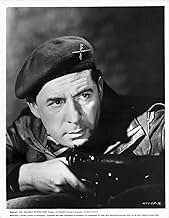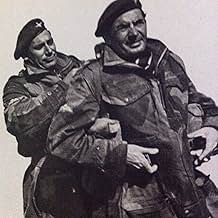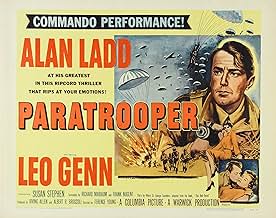IMDb RATING
5.9/10
843
YOUR RATING
In 1940, an American claiming to be Canadian volunteers for the British Army's paratroop school.In 1940, an American claiming to be Canadian volunteers for the British Army's paratroop school.In 1940, an American claiming to be Canadian volunteers for the British Army's paratroop school.
Featured reviews
At the time this film was made (1953) many of the men who took part in ww2 wearing the RED BERET were still around and expecting to see a movie depicting what they had accomplished, and the opening text pays tribute to them somewhat, the film then goes on to a disappointing plot about an American leading man Alan Ladd,whose sole purpose seems to be to sell the movie in the U.S. The action depicting the raid on the Bruneval radar installation is o.k. but the later action which I think is supposed to be the fight in Tunisia gives a very seedy type of appearance,amateur,and certainly unconvincing acting and generally cheap looking sets, possibly a gravel-pit somewhere,(I guess most of the budget was spent on the leading star's salary) although the training scenes were very accurate. It was shot at R.A.F. Abingdon,near Oxford, the Parachute Training School at that time, the Guardroom at the rear gate can be recognized, where they are issued with their Red Berets.Considering all the hard fighting that this regiment actually did in fact do in so many places this had the potential to be a great movie. What was required was a good plot,a good script and less of a romantic storyline and some tight direction, sadly this did not happen and no serious attempt at a movie was made about the heroic actions of the Airborne Forces until "A Bridge Too Far". Other movies like The Cruel Sea, Twelve O'Clock High, Bridge on the River Kwai, King Rat and Das Boot etc.depict the sacrifices made by these men accurately I think, the men who wore the Red Beret must have left this screening very disappointed,I certainly did. Worth having a copy in your collection as I have, if only to think of what might have been.
Not too bad for a typical Alan Ladd movie of its time (released in 1953). Not a must-see but it is entertaining. Having seen this movie a number of times, I was recently surprised to see what appears to be a lot of blue screen shots overlaid on backgrounds. Much of the static dialog seems to be shot on a sound stage and then superimposed on whatever was supposed to be going on in the scene.
Of particular interest is the difference in equipment and training between British and American paratroopers. As with most Alan Ladd movies he's portrayed as the arch-typical quiet loner who, when pushed, reacts with sufficient violence as to be given plenty of space. In reality, Ladd was too small to be much of a menace to most (unless he's pulling a trigger). To give you an idea of how diverse his career was at this time, this movie was released in the same year as his hits "Botany Bay" and "Shane".
Of particular interest is the difference in equipment and training between British and American paratroopers. As with most Alan Ladd movies he's portrayed as the arch-typical quiet loner who, when pushed, reacts with sufficient violence as to be given plenty of space. In reality, Ladd was too small to be much of a menace to most (unless he's pulling a trigger). To give you an idea of how diverse his career was at this time, this movie was released in the same year as his hits "Botany Bay" and "Shane".
From the onset, this movie starts with a serious deficit. Like too many Alan Ladd movies, it inexplicably has Ladd playing an angry man--too angry. He sulks and barks incessantly--like he's suffering from a bad case of PMS. While this sometimes works, here it just makes no sense. Even when you later learn about the supposed source of his anger, it still makes no sense. Having Ladd play a NON-CRAZY guy would have made this a better and more realistic film.
Angry Alan has joined the Canadian Army and has volunteered for paratrooper duty. He's such a good soldier that they want to make him an officer but he refuses each time it is offered. Through the course of his training, he somehow gets a girlfriend--though what she see's in grouchy-boy, I don't know. The audience knows that despite his attitude, somehow Alan will make good by the end of the picture.
In some ways this is a very good production and in others it's a disappointment. The paratroop scenes are very good and appear pretty realistic. Genuine American and British planes were used and the fights look nice as do the jumps. However, at other times it comes off poorly--because the little details were wrong. A few examples include post-WWII markings on an airplane (a minor problem but it should have been fixed) and a scene where the sky color changes back and forth in a sloppy manner. So, in a jump early in the film it's dusk and then looks about half an hour earlier and then half an hour later. Again, not a huge problem but seeing the change so quickly was baffling. The final odd thing is a common cliché--but a dumb one. Again and again you see guys pulling the pins from grenades WITH THEIR TEETH! This is a great way to lose teeth--and no one really ever did this--yet you see it in films repeatedly.
As a result of some decent action, wooden characters (especially Ladd) and a few flubs, I think this is in the category of 'time-passer' and nothing more. Even if Albert Broccoli, Terrence Young and a lot of other future James Bond film crew worked on this, it's only average at best.
Angry Alan has joined the Canadian Army and has volunteered for paratrooper duty. He's such a good soldier that they want to make him an officer but he refuses each time it is offered. Through the course of his training, he somehow gets a girlfriend--though what she see's in grouchy-boy, I don't know. The audience knows that despite his attitude, somehow Alan will make good by the end of the picture.
In some ways this is a very good production and in others it's a disappointment. The paratroop scenes are very good and appear pretty realistic. Genuine American and British planes were used and the fights look nice as do the jumps. However, at other times it comes off poorly--because the little details were wrong. A few examples include post-WWII markings on an airplane (a minor problem but it should have been fixed) and a scene where the sky color changes back and forth in a sloppy manner. So, in a jump early in the film it's dusk and then looks about half an hour earlier and then half an hour later. Again, not a huge problem but seeing the change so quickly was baffling. The final odd thing is a common cliché--but a dumb one. Again and again you see guys pulling the pins from grenades WITH THEIR TEETH! This is a great way to lose teeth--and no one really ever did this--yet you see it in films repeatedly.
As a result of some decent action, wooden characters (especially Ladd) and a few flubs, I think this is in the category of 'time-passer' and nothing more. Even if Albert Broccoli, Terrence Young and a lot of other future James Bond film crew worked on this, it's only average at best.
This film is a very good look at the start of the British airborne forces during World War II. "Paratrooper" was released in America in late December 1953, more than four months after it premiered in the U. K. where it was called "The Red Beret." That is the name of the book from which the film is adapted, written by Hillary St. George Saunders.
Columbia studios clearly made the film for people on both sides of the pond. So, the plot includes an American who enlists in the British Army in Canada. That's OK, and we know quite a few American fliers joined the war effort early by serving in the RAF. Here it provides the love interest part of the film that Hollywood often included for wider audience appeal. But, I think any number of other actors might have filled the role better than Alan Ladd. His Private McKendrick (aka, "Canada") seemed to have a chip on his shoulder. We learn of his background halfway into the film, and one can understand his experience affecting him. But, not that he would be so touchy and angry toward other men. Whatever the reason, his character doesn't come across as genuine.
That aside, I give this film eight stars for its interesting and early look at jump school training and the start of the British Airborne. Years later, I served as a paratrooper in the U. S. 504th and 509th Airborne regiments (1962 through 1964). Americans train at the Ft. Benning, GA, jump school. I became familiar with the British Airborne while stationed in what was then West Germany. We had NATO (North Atlantic Treaty Organization) military exercises in Europe with the Brits, West Germans, and others. And, I was in charge of our airborne PIO (Public Information Office) when we sent one of our troopers through the British jump school. He photographed and reported on it. And, yes, the Brits were still jumping from balloons in training.
From its very beginning jump training has undergone changes, just as the aircraft, equipment and other things have changed. The film shows the first planes the Brits used. They were modified Wellington bombers and men dropped through an opening in the floor. Soon, "Dakotas" (Douglas C-47s) arrived from the U. S., and troopers jumped out of side doors behind the propellers. In 1962, I trained in C-119 "Flying Boxcars," and then jumped from C-130s (Hercules transports) and helicopters in Germany.
The Brits needed to make seven jumps to earn their parachutist wings. We had to make five jumps in the U. S. The film shows training in hand-to-hand combat. Americans got that in advanced infantry training before Jump School. We don't see any other physical training in the film, but all paratroopers have much more rigorous physical conditioning. One thing was glaring to me - I didn't see a single trooper land with a PLF (parachute landing fall). Maybe this wasn't developed until well after the war, but PLF landing had tremendous results in reducing injuries. In a nutshell, the trooper is trained to turn or orient his chute for a side landing, and then in a relaxed position as his feet touch the ground, he rolls his body to the right or left, with his calf, then hip, then side absorbing the impact. In the 17 jumps I made, I only got hurt once, when I landed on a big boulder right in the middle of my back.
In this movie, Stanley Baker plays one of the training cadre, Sgt. Breton. On the first airplane jump, his chute fails to open and he falls to his death. The Brits called his malfunction a Roman candle. In the American airborne, we call it a cigarette roll. But it's interesting that the Brits apparently didn't carry reserve chutes. They didn't appear to have them on in the film. So far as I know, American paratroopers always have had a reserve chute on the front. If anyone had a cigarette roll or other malfunction, he would release the main chute and pull the ripcord on his reserve. I saw half a dozen or more uses of the reserves in my airborne service. Some other things missing from this film were training jumps from towers. In one scene, I can see what looks like a 250-foot tower in the background. I also enjoyed the portrayal of the chute packing unit. It's too bad they didn't show the actual packing tables. And the funniest thing in this film is the strange looking headgear the Brits wore in jump school.
"Paratrooper" is a good portrayal of the early action of the British Airborne. I thank Steve Crook from London, who's review tipped me off to the background of Major Snow. Leo Genn plays the part very well in this film. Snow was John Frost in real life. He became best known after his paratrooper battalion took the north end of the Arnhem Bridge in Operation Market Garden in September 1944. The Brits held out four days against a German Panzer division. They were captured only after they ran out of ammunition. In the 1977 blockbuster movie, "A Bridge Too Far," Anthony Hopkins plays Lt. Col. Frost beautifully. Frost retired as a Major General in 1968, and was a close adviser on that film.
The only thing I see wrong in this movie is the name of the first operation the troopers had. Major Snow calls it "Operation Pegasus." In fact, it was called Operation Biting, also known as the Bruneval Raid. There was a real Operation Pegasus, and it was the escape plan across the Rhine River for many of the Brits trapped by the Germans in Operation Market Garden.
War movie fans and those who like history especially should enjoy this film.
Columbia studios clearly made the film for people on both sides of the pond. So, the plot includes an American who enlists in the British Army in Canada. That's OK, and we know quite a few American fliers joined the war effort early by serving in the RAF. Here it provides the love interest part of the film that Hollywood often included for wider audience appeal. But, I think any number of other actors might have filled the role better than Alan Ladd. His Private McKendrick (aka, "Canada") seemed to have a chip on his shoulder. We learn of his background halfway into the film, and one can understand his experience affecting him. But, not that he would be so touchy and angry toward other men. Whatever the reason, his character doesn't come across as genuine.
That aside, I give this film eight stars for its interesting and early look at jump school training and the start of the British Airborne. Years later, I served as a paratrooper in the U. S. 504th and 509th Airborne regiments (1962 through 1964). Americans train at the Ft. Benning, GA, jump school. I became familiar with the British Airborne while stationed in what was then West Germany. We had NATO (North Atlantic Treaty Organization) military exercises in Europe with the Brits, West Germans, and others. And, I was in charge of our airborne PIO (Public Information Office) when we sent one of our troopers through the British jump school. He photographed and reported on it. And, yes, the Brits were still jumping from balloons in training.
From its very beginning jump training has undergone changes, just as the aircraft, equipment and other things have changed. The film shows the first planes the Brits used. They were modified Wellington bombers and men dropped through an opening in the floor. Soon, "Dakotas" (Douglas C-47s) arrived from the U. S., and troopers jumped out of side doors behind the propellers. In 1962, I trained in C-119 "Flying Boxcars," and then jumped from C-130s (Hercules transports) and helicopters in Germany.
The Brits needed to make seven jumps to earn their parachutist wings. We had to make five jumps in the U. S. The film shows training in hand-to-hand combat. Americans got that in advanced infantry training before Jump School. We don't see any other physical training in the film, but all paratroopers have much more rigorous physical conditioning. One thing was glaring to me - I didn't see a single trooper land with a PLF (parachute landing fall). Maybe this wasn't developed until well after the war, but PLF landing had tremendous results in reducing injuries. In a nutshell, the trooper is trained to turn or orient his chute for a side landing, and then in a relaxed position as his feet touch the ground, he rolls his body to the right or left, with his calf, then hip, then side absorbing the impact. In the 17 jumps I made, I only got hurt once, when I landed on a big boulder right in the middle of my back.
In this movie, Stanley Baker plays one of the training cadre, Sgt. Breton. On the first airplane jump, his chute fails to open and he falls to his death. The Brits called his malfunction a Roman candle. In the American airborne, we call it a cigarette roll. But it's interesting that the Brits apparently didn't carry reserve chutes. They didn't appear to have them on in the film. So far as I know, American paratroopers always have had a reserve chute on the front. If anyone had a cigarette roll or other malfunction, he would release the main chute and pull the ripcord on his reserve. I saw half a dozen or more uses of the reserves in my airborne service. Some other things missing from this film were training jumps from towers. In one scene, I can see what looks like a 250-foot tower in the background. I also enjoyed the portrayal of the chute packing unit. It's too bad they didn't show the actual packing tables. And the funniest thing in this film is the strange looking headgear the Brits wore in jump school.
"Paratrooper" is a good portrayal of the early action of the British Airborne. I thank Steve Crook from London, who's review tipped me off to the background of Major Snow. Leo Genn plays the part very well in this film. Snow was John Frost in real life. He became best known after his paratrooper battalion took the north end of the Arnhem Bridge in Operation Market Garden in September 1944. The Brits held out four days against a German Panzer division. They were captured only after they ran out of ammunition. In the 1977 blockbuster movie, "A Bridge Too Far," Anthony Hopkins plays Lt. Col. Frost beautifully. Frost retired as a Major General in 1968, and was a close adviser on that film.
The only thing I see wrong in this movie is the name of the first operation the troopers had. Major Snow calls it "Operation Pegasus." In fact, it was called Operation Biting, also known as the Bruneval Raid. There was a real Operation Pegasus, and it was the escape plan across the Rhine River for many of the Brits trapped by the Germans in Operation Market Garden.
War movie fans and those who like history especially should enjoy this film.
Somehow 'The Red Beret,' by no measure a fine film, remains one of my sentimental favorites, perhaps because in my teens it aired often on late night TV, under its U.S. title 'Paratrooper.' Alan Ladd, even when he wasn't acting, appeared as the sexy strong stoical silent type, and here he again fills that bill. I also love this film because it's one of the many that carved out for Harry Andrews his reputation for playing tough-tender sergeants and sergeant majors; in 'The Red Beret' his last-words line, "Pity the man who hears the pipes and was na born in Scotland," has stuck pleasantly with me into my sixth decade; he also gives a lovely little take when the red berets are issued to him and his men and his character must part with his beloved regimental headgear. Also very sexy here, in his own astute, urbane way - quite different from Ladd's, is Leo Genn (who, in my experience, never gave a poor screen performance, and who was very good as the psychiatrist in 'The Snake Pit' and as Mr. Starbuck in John Huston's adaptation of 'Moby Dick'). Pert, pretty Susan Stephen - in a curls-and-frizz hairdo that was fifteen years ahead of its time! - doesn't act very well here, but I still find her effort affecting as Ladd's character's love interest.
I suppose my affection for 'The Red Beret' is one more proof that "There's no accounting for taste." Which helps to explain, if not to excuse, most of the rubbish studios churn out nowadays for uncritical mass consumption. I wish 'The Red Beret' would release on disc so that once, and many times over, in the wee hours I could snuggle down on the sofa and enjoy it as I did when I was a teenager.
I suppose my affection for 'The Red Beret' is one more proof that "There's no accounting for taste." Which helps to explain, if not to excuse, most of the rubbish studios churn out nowadays for uncritical mass consumption. I wish 'The Red Beret' would release on disc so that once, and many times over, in the wee hours I could snuggle down on the sofa and enjoy it as I did when I was a teenager.
Did you know
- TriviaStanley Baker is dubbed.
- GoofsRight before the raid on the airfield at Bone, some of the paratroops bolt for a taxiing DC-3 and, without official authorization, climb aboard, so as not to miss their chance to take part in the airborne assault. This DC-3 has distinctive side markings, including a very visible "602" on the tail. Yet, when these same paratroops jump from this same plane, the side markings are now completely different, not the least of which is the total absence of the "602" tail number. The serial appears as "TG602". TG602 was an RAF Handley Page Hastings C1, the standard RAF Transport Command aircraft used for para dropping and current at RAF Abingdon, in 1952-1953. RAF Hastings served at that time in a natural aluminum finish. The filming of this particular aircraft occurred prior to 12 January 1953, which is when it was lost in an accident in Egypt.
- ConnectionsFeatured in Everything or Nothing (2012)
- SoundtracksRed River Valley
(uncredited)
Traditional, lyrics modified as a parachutists' song
Sung on the pub, and whistled and hummed throughout the film as a theme
- How long is Paratrooper?Powered by Alexa
Details
Box office
- Budget
- $700,000 (estimated)
- Runtime1 hour 28 minutes
- Color
- Aspect ratio
- 1.37 : 1
Contribute to this page
Suggest an edit or add missing content


































